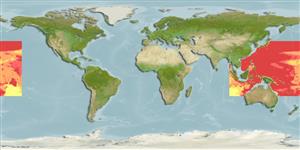Teleostei (teleosts) >
Myctophiformes (Lanternfishes) >
Myctophidae (Lanternfishes) > Diaphinae
Etymology: Diaphus: Greek, dis, dia = through + Greek, physa, phyo = to beget, to have as offspring (Ref. 45335).
More on authors: Gilbert & Cramer.
Environment: milieu / climate zone / depth range / distribution range
Ecology
Marine; bathypelagic; depth range 213 - 587 m (Ref. 44036). Deep-water; 41°N - 25°S, 95°E - 154°W
Pacific Ocean.
Size / Weight / Age
Maturity: Lm ? range ? - ? cm
Max length : 1.1 cm SL male/unsexed; (Ref. 44036)
Meso- (Ref. 58302, 75154) and benthopelagic in nearshore areas at 0-190 m at night, 418-960 m during day (Ref. 58302).
Life cycle and mating behavior
Maturity | Reproduction | Spawning | Eggs | Fecundity | Larvae
De la Paz, R.M. and R. Interior, 1979. Deep-sea fishes off Lubang Island, Philippines. Nat. Applied Sci. Bull. 31(3-4):175 p. (Ref. 5282)
IUCN Red List Status (Ref. 130435)
Threat to humans
Harmless
Human uses
More information
Age/SizeGrowthLength-weightLength-lengthLength-frequenciesMorphometricsMorphologyLarvaeLarval dynamicsRecruitmentAbundanceBRUVS
ReferencesAquacultureAquaculture profileStrainsGeneticsElectrophoresesHeritabilityDiseasesProcessingNutrientsMass conversion
Tools
Can't connect to MySQL database fbquizv2. Errorcode: Too many connections
